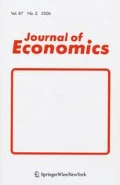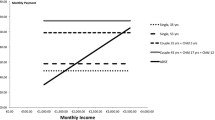Abstract
This study analyses self-insurance and saving decisions in a two-period model when the utility function depends on income and health. In this study, we consider an intertemporal and multi-dimensional cost–benefit structure of self-insurance and saving, unlike in the standard one-argument utility model. We show that the impacts of the changes in initial income and health on self-insurance and saving depend on whether an individual is correlation averse or not, the comparison between the absolute risk aversion and the absolute correlation aversion, and the comparison between the income effect and the substitution effect. We also show that self-insurance and saving can be either complements or substitutes.
Similar content being viewed by others
Change history
16 June 2021
A Correction to this paper has been published: https://doi.org/10.1007/s00712-021-00748-6
Notes
Self-protection is a care activity that lowers the probability of loss, while self-insurance (or loss reduction) is an activity that decreases the amount of loss. See Ehrlich and Becker (1972) for more detail. In this study, we use risk reduction as a generic term.
The case in which only income loss can occur is not the focus of our analysis, because this case is equivalent to the one-argument utility model. See, Lee (2005).
More precisely, Liu and Menegatti (2019a, b) compare the elasticity of the marginal utilities of saving with respect to the cost and benefit of health investment (or health prevention) to examine the Edgeworth-Pareto type of complementarity/substitutability between saving and health investment (or health prevention).
References
Briys E, Schlesinger H (1990) Risk aversion and the propensities for self-insurance and self-protection. South Econ J 57(2):458–467
Courbage C, Rey B (2006) Prudence and optimal prevention for health risks. Health Econ 15:1323–1327
Crainich, D, Eeckhoudt L, Courtois OL (2014) An index of (absolute) correlation aversion: theory and some implications. Working Paper
Dionne G, Eeckhoudt L (1984) Insurance and saving: some further results. Insur Math Econ 3(2):101–110
Dionne G, Eeckhoudt L (1985) Self-insurance, self-protection and increased risk aversion. Econ Lett 17:39–42
Edwards RD (2008) Health risk and portfolio choice. J Bus Econ Stat 26(4):472–485
Eeckhoudt L, Gollier C (2005) The impact of prudence on optimal prevention. Econ Theor 26:989–994
Eeckhoudt L, Rey B, Schlesinger H (2007) A good sign for multivariate risk taking. Manage Sci 53:117–124
Ehrlich I, Becker GS (1972) Market insurance, self-insurance, and self-protection. J Polit Econ 90:623–648
Epstein LG, Tanny SM (1980) Increasing generalized correlation: a definition and some economic consequences. Can J Econ 13(1):16–34
Evans WN, Viscusi WK (1991) Estimation of state-dependent utility functions using survey data. Rev Econ Stat 73(1):94–104
Finkelstein A, Luttmer EFP, Notowidigdo MJ (2009) Approaches to estimating the health state dependence of the utility function. Am Econ Rev Pap Proc 99(2):116–121
Finkelstein A, Luttmer EFP, Notowidigdo MJ (2013) What good is wealth without health? The effect of health on the marginal utility of consumption. J Eur Econ Assoc 11(1):221–258
Hofmann A, Peter R (2016) Self-insurance, self-protection, and saving: on consumption smoothing and risk management. J Risk Insur 83(3):719–734
Kim KS, Seog SH (2020a) Asset sensitivity and risk selection. Working Paper
Kim KS, Seog SH (2020b) Insurance and moral hazard when insurable asset and income are separable. Working Paper
Lee K (2005) Wealth effects on self-insurance and self-protection against monetary and nonmonetary losses. Geneva Risk Insur Rev 30:147–159
Lee K (2007) Wealth, income, and optimal insurance. J Risk Insur 74:175–184
Lee K (2010) Risk aversion and self-insurance. J Econ 101:277–282
Lillard LA, Weiss Y (1997) Uncertain health and survival: effects on end-of-life consumption. J Bus Econ Stat 15(2):254–268
Liu D, Menegatti M (2019a) Precautionary investment in wealth and health. J Risk Insur 86(1):237–255
Liu D, Menegatti M (2019b) Optimal saving and health prevention. J Econ 128:177–191
Menegatti M (2009) Optimal prevention and prudence in a two-period model. Math Soc Sci 58:393–397
Menegatti M (2014) Optimal choice on prevention and cure: a new economic analysis. Eur J Health Econ 15(4):363–372
Menegatti M, Rebessi F (2011) On the substitution between saving and prevention. Math Soc Sci 62:176–182
Rey B, Rochet JC (2004) Health and wealth: How do they affect individual preferences? Geneva Pap Risk Insur Theory 29:43–54
Richard S (1975) Multivariate risk aversion utility independence and separable utility functions. Manage Sci 22(1):12–21
Sloan FA, Viscusi WK, Chesson HW, Conover CJ, Whetten-Goldstein K (1998) Alternative approaches to valuing intangible health losses: the evidence for multiple sclerosis. J Health Econ 17:475–497
Viscusi WK, Evans WN (1990) Utility functions that depend on health status: estimates and economic implications. Am Econ Rev 80(3):353–374
Author information
Authors and Affiliations
Corresponding author
Additional information
Publisher's Note
Springer Nature remains neutral with regard to jurisdictional claims in published maps and institutional affiliations.
The original online version of this article was revised: The missing part in Proposition 3 (3) (ii) has been corrected in original article.
Appendices
Appendix
Proof of Proposition 1
We prove Proposition 1 (1) in the case of \(u_{CA} < 0\). From Eq. (8), we have \(\frac{de}{{dy}} > 0\) if and only if:
Using Eq. (7), we have the following inequality:
Then, we obtain Eq. (9) by rewriting equation (A1) as follows:
Next, to prove Proposition 1 (2), we totally differentiate Eq. (6) with respect to \(h\):
From equation (A2), if \(u_{CA} \ge 0\), we have \(\frac{de}{{dh}} < 0\). Contrarily, if \(u_{CA} < 0\), we have \(\frac{de}{{dh}} < 0\) if and only if:
We can obtain Eq. (11) by rewriting inequality (A3) as follows:
Proof of Lemma 2
To prove Lemma 2, let us first rearrange Eq. (23) as follows:
From Eq. (24), the sign of \(\frac{de}{{ds}}\) is identical to the sign of \(U_{es}\). The condition for \(U_{es} < 0\) is as follows:
Using Eq. (22) and (A4), inequality (A5) can be written as follows:
Proof of Proposition 3
By totally differentiating Eqs. (21) and (22) with respect to \(y_{0}\), \({\text{y}}_{1}\) and \(h\), and using Cramer’s Rule, we have the following:
where \(e^{*}\) and \(s^{*}\) are optimal self-insurance and saving, respectively,
\(U_{{ee}} = u_{C} \left( {y_{0} - f\left( e \right) - s,~h} \right)\left( { - f^{\prime\prime}\left( e \right)} \right) + u_{{CC}} \left( {y_{0} - f\left( e \right) - s,~h} \right)\left\{ {f^{\prime}\left( e \right)} \right\}^{2} + \beta pu_{A} \left( {y_{1} + Rs,~h - l\left( e \right)} \right)l^{\prime\prime}\left( e \right) + \beta pu_{{AA}} \left( {y_{1} + Rs,~h - l\left( e \right)} \right)\left\{ {l^{\prime}\left( e \right)} \right\}^{2} < 0\) by the second-order condition,
and \(\left| H \right| = U_{ee} U_{ss} - \left( {U_{es} } \right)^{2} > 0\) by the second-order condition. Note that we explicitly assume that the second-order conditions hold, as in the literature (Dionne and Eeckhoudt 1984; Menegatti and Rebessi, 2011; Liu and Menegatti 2019a, b).
4.1 Proof of Proposition 3 (1)
From equation (A7), and by using equation (A4), we can obtain inequality (27), the condition for \(\frac{de}{{dy_{0} }} > 0\):
From equation (A10), and since \(U_{ee} < 0\), the sign of \(\frac{ds}{{dy_{0} }}\) is identical to the sign of the inequality (28):
By combining inequality (27) and (28), the following statements prove Proposition 3 (1):
-
(i)
In the case of \(u_{CA} > 0\), we obviously have \(\frac{de}{{dy_{0} }} > 0\), and if \(\frac{{u_{CC} \left( {y_{0} - f\left( e \right) - s, h} \right)}}{{u_{C} \left( {y_{0} - f\left( e \right) - s, h} \right)}} + R\frac{{u_{CA} \left( {y_{1} + Rs, h - l\left( e \right)} \right)}}{{u_{A} \left( {y_{1} + Rs, h - l\left( e \right)} \right)}} > 0\), then we have \(\frac{ds}{{dy_{0} }} > 0\).
-
(ii)
In the case of \(u_{CA} < 0\), we automatically have \(U_{se} < 0\), and if \(- \frac{{u_{CA} \left( {y_{1} + Rs, h - l\left( e \right)} \right)}}{{u_{A} \left( {y_{1} + Rs, h - l\left( e \right)} \right)}} < - \frac{{Eu_{CC} \left( {y_{1} + Rs, \tilde{h}} \right)}}{{Eu_{C} \left( {y_{1} + Rs, \tilde{h}} \right)}}\), then we have \(\frac{de}{{dy_{0} }} > 0\), while the sign of \(\frac{ds}{{dy_{0} }}\) is ambiguous.
4.2 Proof of Proposition 3 (2)
The proof is similar to that of Proposition 3 (1), so is omitted here.
4.3 Proof of Proposition 3 (3)
From equation (A9), and since \(U_{ss} < 0\), the condition for \(\frac{de}{{dh}} < 0\) is as follows:
To examine the sign of (A13), let us first suppose that Lemma 2 holds (\(U_{es} < 0\)). Then, we have \(U_{eh} < 0\), if \(u_{CA} \ge 0\), or if \(u_{CA} < 0\) and the following inequality holds:
Moreover, we have \(U_{sh} > 0\) if:
Thus, we obtain \(\frac{de}{{dh}} < 0\), if Lemma 2 and inequalities (A14) and (A15) hold.
On the contrary, now we suppose that Lemma 2 does not hold (\(U_{es} > 0\)). Then, since \(U_{eh} < 0\), we have \(\frac{de}{{dh}} < 0\) if \(U_{sh} < 0\), that is, the following holds:
Next, from equation (A12), the sign of \(\frac{ds}{{dh}}\) is identical to the sign of the following:
Combining inequality (A13) and (A17), the following statements prove Proposition 3 (3):
-
(i)
(a) In the case of \(u_{CA} > 0\), we automatically have \(U_{eh} < 0\). If \(\frac{{u_{CC} \left( {y_{0} - f\left( e \right) - s, h} \right)}}{{u_{C} \left( {y_{0} - f\left( e \right) - s, h} \right)}} + R\frac{{u_{CA} \left( {y_{1} + Rs, h - l\left( e \right)} \right)}}{{u_{A} \left( {y_{1} + Rs, h - l\left( e \right)} \right)}} < 0\) and \(- \frac{{u_{CA} \left( {y_{0} - f\left( e \right) - s, h} \right)}}{{u_{C} \left( {y_{0} - f\left( e \right) - s, h} \right)}} > - \frac{{Eu_{CA} \left( {y_{1} + Rs, \tilde{h}} \right)}}{{Eu_{C} \left( {y_{1} + Rs, \tilde{h}} \right)}}\), then we have \(U_{sh} > 0\) and \(U_{se} < 0\) and, thus, \(\frac{de}{{dh}} < 0\) and \(\frac{ds}{{dh}} > 0\).
(b) In the case of \(u_{CA} < 0\), we automatically have \(U_{es} < 0\), and if \(- \frac{{Eu_{CA} \left( {y_{1} + Rs, \tilde{h}} \right)}}{{Eu_{C} \left( {y_{1} + Rs, \tilde{h}} \right)}} < - \frac{{u_{CA} \left( {y_{0} - f\left( e \right) - s, h} \right)}}{{u_{C} \left( {y_{0} - f\left( e \right) - s, h} \right)}} < - \frac{{u_{AA} \left( {y_{1} + Rs, h - l\left( e \right)} \right)}}{{u_{A} \left( {y_{1} + Rs, h - l\left( e \right)} \right)}}\), then we have \(U_{eh} < 0\) and \(U_{sh} > 0\). Therefore, we obtain \(\frac{de}{{dh}} < 0\) and \(\frac{ds}{{dh}} > 0\).
-
(ii)
In the case of \(u_{CA} > 0\), if \(\frac{{u_{CC} \left( {y_{0} - f\left( e \right) - s, h} \right)}}{{u_{C} \left( {y_{0} - f\left( e \right) - s, h} \right)}} + R\frac{{u_{CA} \left( {y_{1} + Rs, h - l\left( e \right)} \right)}}{{u_{A} \left( {y_{1} + Rs, h - l\left( e \right)} \right)}} > 0\) and \(- \frac{{u_{CA} \left( {y_{0} - f\left( e \right) - s, h} \right)}}{{u_{C} \left( {y_{0} - f\left( e \right) - s, h} \right)}} < - \frac{{Eu_{CA} \left( {y_{1} + Rs, \tilde{h}} \right)}}{{Eu_{C} \left( {y_{1} + Rs, \tilde{h}} \right)}}\), then we have \(U_{eh} < 0\), \(U_{sh} < 0\) and \(U_{se} > 0\). Therefore, we have \(\frac{de}{{dh}} < 0\) and \(\frac{ds}{{dh}} < 0\).
Rights and permissions
About this article
Cite this article
Hong, J., Kim, K. Self-insurance and saving under a two-argument utility framework. J Econ 134, 73–94 (2021). https://doi.org/10.1007/s00712-021-00738-8
Received:
Accepted:
Published:
Issue Date:
DOI: https://doi.org/10.1007/s00712-021-00738-8




